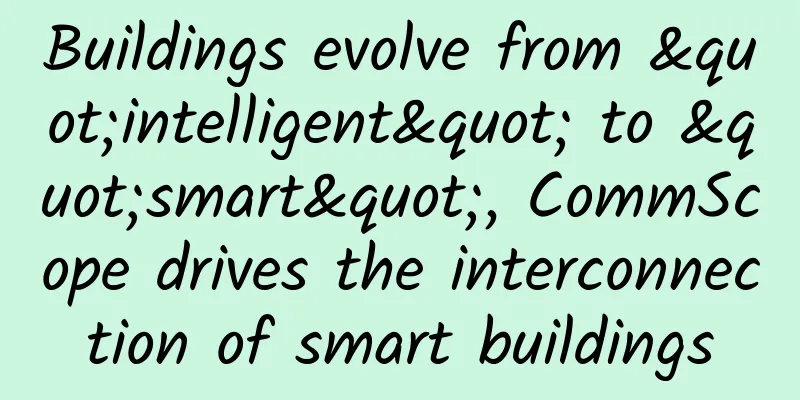Buildings evolve from "intelligent" to "smart", CommScope drives the interconnection of smart buildings

|
[Original article from 51CTO.com] June 5, 2018 - From June to August 2018, CommScope will hold the "2018 CommScope Greater China Smart Building Tour" in China, focusing on the evolution trend of network technology, which will drive the transformation of buildings from smart to intelligent. While smart buildings may already have the latest digital infrastructure, "intelligent" buildings integrate data from IT, facilities and operational systems to provide a dashboard that displays all network traffic in real time. This data can be used to report on energy usage, emissions and other indicators. Industry leaders CommScope, Cisco and Signify (formerly Philips Lighting) will focus on structured cabling and Power over Ethernet (PoE), demonstrating the bandwidth and power capabilities that enable buildings to evolve towards intelligence. “The Internet of Things (IoT) is redefining smart buildings as more connected devices demand high bandwidth and low latency,” said Lan Chen, vice president of CommScope Enterprise Networks North Asia. “As buildings become smarter, CommScope supports connectivity with an integrated communications infrastructure that supports wired and wireless networks and applications. We combine our own networking technology with the innovations of our partners to deliver a smart, comprehensive experience for building users.”
Four major network technology trends affect the evolution of buildings from "intelligent" to "smart": The next generation of the workforce is driving demand for increased in-building mobility According to a survey conducted by a German Internet company, Chinese people spend an average of three hours a day on their smartphones, ranking second globally after Brazil. Generation Z (13-22 years old) checks their phones every three minutes and consumes 2-3 times as much data, according to the Generation Z: Tech Confidant Study. China is currently experiencing a trend similar to that of the UK, with two-thirds of employees believing that indoor wireless connectivity is essential and 77% of respondents believing that indoor wireless connectivity can improve labor productivity[1]. · Network security is critical to ubiquitous mobility As wireless networks continue to develop, the Internet of Things has also been included. When everyday devices are embedded with intelligence and can transmit data, more network vulnerabilities will also appear. For example, vending machines may become a weak link for hackers to invade corporate LANs. Therefore, smart buildings can use automated infrastructure management systems to detect unauthorized access throughout the network and buildings. Power supply management is key to efficient operations The massive adoption of IP internetworking devices in modern enterprises has not only driven the demand for faster data rates, but also increased the requirements for power supply. With PoE, devices can achieve data and power connections through a single Ethernet copper cable, thereby reducing installation and maintenance costs. Improving office efficiency is becoming increasingly important Building owners are rethinking how to attract tenants through more sustainable work environments. A recent report on Generation Z’s views on work and the workplace showed that 76% of respondents said they are concerned about the impact humans are having on the planet and believe they can drive change. Statistics show that owners need to think about the sustainability of their workplaces, from natural light in spaces to energy performance. For example, Glumac’s building in Shanghai allows employees to monitor indoor and outdoor air quality through a mobile app. The Edge Building in Amsterdam provides employees with a state-of-the-art gym and is able to recycle the energy they consume to run the building. Shaping the “Always-On” Business Future Smart communities are defined as the intermediate transition between smart cities and smart buildings. Multi-building campuses or multi-purpose commercial centers in cities are also affected by the above four trends and can be managed profitably under the guidance of a strategic approach. In the future, it is possible to deploy network capacity to hotspots, provide wireless services to attract visitors, and make better business decisions through analysis. "Smart buildings are part of a larger plan to develop smart cities. China plans to build 100 new smart cities by 2020, and mobility, security, energy and efficiency will affect the type of network infrastructure used in offices, hotels, public places and communities," added Chen Lan. "Higher bandwidth and larger power distribution are shaping the future of 'always-on' business." [51CTO original article, please indicate the original author and source as 51CTO.com when reprinting on partner sites] |
Recommend
Huawei's bank-level temperature control market share in China ranks first and continues to lead
During the 4th Data Center Infrastructure Summit ...
5G messaging is now available for trial use. Will it replace WeChat?
Will 5G messaging, known as a "killer" ...
Huawei releases MetaAAU, reducing energy consumption by 30% and improving performance and energy saving
Today, at the China (Beijing) International Infor...
The turning point has arrived: NB-IoT industry is accelerating its release!
The birth of any new technology is always met wit...
DNS record types
[[400276]] This article is reprinted from the WeC...
Where did smart watches lose out?
【51CTO.com Quick Translation】 The failure of smar...
Tencent Cloud Flash Sale: 1C2G5M=488 yuan/3 years, 1C1G3M=268 yuan/3 years, available in Shanghai/Beijing/Guangzhou/Chengdu
Tencent Cloud's long-term flash sales activit...
HostingViet November Offer: Vietnam VPS 30% off for monthly payment/40% off for half-year payment/double configuration for annual payment
Last month, I shared information about HostingVie...
Deepin Technology participated in the national highway video networking work research meeting
On November 28, 2019, in order to accelerate the ...
In the 5G era, limited spectrum is used in a variety of ways
A spectrum comparable to gold Wireless spectrum i...
Technology “hidden” by life: WIFI
Nowadays, we use WIFI so many times every day tha...
Take a look at Sigfox, LoRa, and NB-IoT: wireless transmission technologies in the era of the Internet of Things
Wireless communication technology is the transmis...
Misaka: $44/year KVM-2GB/32G NVMe/2TB/Germany (optional CN2)
Misaka is a Chinese merchant (the same company as...









